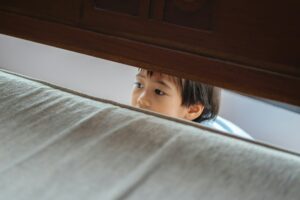Night terrors in kids (also known as sleep terrors) are a parasomnia sleep disorder characterized by episodes of screaming and panic while the child is still asleep. (“Parasomnia” is a catchall term used to describe unusual behaviors people experience before falling asleep, while asleep, or during the period when the brain transitions in and out of sleep, such as sleepwalking, sleep talking, or night terrors, according to the Sleep Foundation).
Typically, it happens two to three hours after the child first falls asleep, during the deep sleep, NREM (non-rapid eye movement) stage of the sleep cycle, and can last up to thirty minutes or more. The child’s eyes may be wide open, and he or she may look awake, but his or her brain is not.
Night terrors in kids are most common between the ages of three and six, although they have been known to occur in children as young as eighteen months and as old as twelve years of age. Episodes can be dramatic and alarming to witness, but they are not usually harmful, and kids almost always grow out of them by early adolescence.
What is the difference between a nightmare and a night terror?
Nightmares are most common toward the end of the night during the light sleep, rapid eye movement (REM) dream stage of the sleep cycle. The child wakes up frightened but does not exhibit the physical or vocal behaviors characteristic of night terrors. He or she seeks comfort, can remember the scary dream, and may be afraid to go back to sleep.
Night terrors, on the other hand, usually occur two to three hours after your child falls asleep, at the end of the deep sleep non-REM stage when the brain starts transitioning between cycles. The child is unable to transition smoothly from the deepest stage of sleep to the lighter one and is caught in between. He or she looks awake even though still asleep, is terrified by the experience, but will have no recollection of it upon awakening the next morning.
Factors that can contribute to night terrors in kids
- Being overtired or sleep-deprived.
- Stress.
- Being disturbed during the night by loud noises or light.
- Fever.
- Sleep apnea.
- A full bladder.
- Family history of parasomnia sleep disorders.
Signs of night terrors in kids
- Bolting upright in bed and acting scared and distressed.
- Crying, screaming, kicking, talking gibberish, thrashing wildly, or jumping out of bed as though trying to run away from someone or something.
- Sweating, rapid heartbeat, and/or heavy breathing.
- Eyes wide open, but unresponsive and unaware of your presence.
- Becoming more agitated and pushing you away if you try to comfort or calm them.
- The episode ends as abruptly as it started, and the child falls back asleep.
- No recollection of the episode when they wake up.
Things to do and not do
- Make sure the area around your child’s bed is safe, there are no tripping hazards such as toys or electric cords, and sharp objects are removed.
- Close and lock windows and doors at night and block off the stairs to prevent your child from falling.
- Do not leave your child alone. Sit tight and focus on keeping him or her from hurting him or herself.
- Do not try to restrain or wake your child up as it can make him or her more agitated and cause the episode to last longer.
- If your child starts sleepwalking, try to gently guide him or her back to bed.
Strategies to help prevent night terrors
 Make sure your child gets enough sleep
Make sure your child gets enough sleep
Overtiredness is one of the main causes of night terrors. The best way to prevent them is to ensure your child gets adequate, consistent sleep and is not disturbed during the night by loud noises or light.
Establish a consistent and relaxing sleep routine
Establishing a relaxing tuck-in routine such as having a warm bath, listening to lullabies, or reading a bedtime story can help your child wind down for bed and signal that it’s time for sleep.
Empty bladder
Make sure your child goes to the toilet and empties his or her bladder before going to sleep.
Avoid caffeine
Check labels to make sure your child is not consuming too much caffeine such as in chocolate or snack bars.
Limit screen time before bed
Avoid using electronics before bedtime. The blue light they emit can disrupt your child’s circadian rhythm (internal clock).
Avoid overstimulation close to bedtime
Avoid over-stimulating your child close to bedtime by roughhousing or playing games.
Interrupt the night terror cycle
Look for patterns, and if your child tends to have a night terror at the same time every night, wake him or her up about fifteen minutes before the anticipated time and then go back to sleep again after a few minutes.
If you have questions or would like to meet with one of the counselors at Allen Christian Counseling in Texas, please don’t hesitate to give us a call.
References:
David Metzger. “What to Know About Night Terrors in Toddlers and Young Children.” Parents. Updated August 19, 2023. parents.com/kids/sleep/issues/night-terrors-in-kids-how-to-help/.“Night Terrors.” (Reviewed by Amy W. Anzilotti, MD). Nemours KidsHealth. Reviewed July 2023. kidshealth.org/en/parents/terrors.html.
Photos:
“Peeking”, Courtesy of bady abbas, Unsplash.com, CC0 License
- Sandra Stein: Author
Sandra Kovacs Stein was born in Calcutta, India, grew up in the Dominican Republic, and went to school in Canada, where she planned to settle after getting her Master’s degree in Speech Pathology and Audiology. Instead, she fell in love with an Ameri...
DISCLAIMER: THIS ARTICLE DOES NOT PROVIDE MEDICAL ADVICE
Articles are intended for informational purposes only and do not constitute medical advice; the content is not intended to be a substitute for professional medical advice, diagnosis, or treatment. All opinions expressed by authors and quoted sources are their own and do not necessarily reflect the opinions of the editors, publishers or editorial boards of Stone Oak Christian Counseling. This website does not recommend or endorse any specific tests, physicians, products, procedures, opinions, or other information that may be mentioned on the Site. Reliance on any information provided by this website is solely at your own risk.




